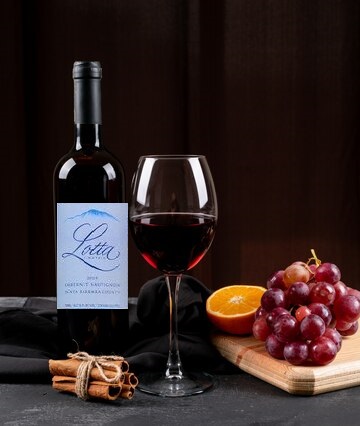Wine provides numerous health benefits, including preventing heart disease and stroke. It can also help you live longer! Wine is an alcoholic drink made by fermenting grapes or other fruits/plants. Different wines vary in sweetness, acidity, tannin content, flavor, and body, depending on the fermentation process.
Wine is America’s most popular alcoholic beverage, beating beer and spirits. Red wine is one of the most consumed variants, so let’s explore its nutritional value.
How Many Calories Are There In a Bottle of Red Wine from Lotta Vineyard?
It’s essential to comprehend why some wines have a higher calorie content than others. To begin, the calories in wine come from two places, alcohol and sugar. Usually, a wine with a higher alcohol rate is also higher in calories. The reason is that alcohol has approximately seven calories per gram, whereas carbs and proteins only have four.
In short, this means that even very sweet and low-alcohol wines will not be as high in calories as a dry red wine with higher alcohol content. At this moment, mentioned is a list of the most popular types of red wine and their calorie counts:
- Pinot Noir – 620 calories per bottle.
- Zinfandel – 660 calories per bottle
- Burgundy – 650 calories per bottle
- Barbera – 625 calories per bottle
- Sangiovese – 630 calories per bottle
- Cabernet – 625 calories per bottle
Ensure that Your Dark Fruit Wine is a High Quality
Remember that the alcohol content in wine varies depending on the type of grape used. To ensure a particular bottle’s strength, check the ABV (alcohol by volume) percentage on the label. The higher the ABV, the more calories there are in a glass.
If you need to become more experienced with picking wine, ask your bartender or server for a recommendation of a lower-ABV red wine. These types of wines are becoming more popular and easy to find. Do some research online before going out to make sure you find one you’ll enjoy drinking.
Is There a Correlation Between Low-calorie Wines and Fewer Calories?
The ABV (alcohol by volume) and alcohol calories listed on the wine label will tell you how many calories are in a glass. Some low-calorie wines may have 100 calories per 150ml glass but contain 12% ABV. Others might have 89 calories per glass with an 8.5 percent alcohol content.
The wine with 8.5% alcohol is the best choice if you’re calorie-conscious. Although, all classic dry wines are relatively low in calories. So even though you might be cutting back, there’s no need to analyze it and second-guess your decision by opting for a “low-calorie” bottle of goodness.
Health Benefits of Drinking Red Wine
Not only does red wine taste great, but it also contains the antioxidant resveratrol, which has been linked to various health advantages. So next time you feel guilty about pouring yourself a glass (or two), don’t!
- Lower bad cholesterol
- Proof can help to regulate blood sugar and blood pressure.
- Red wine benefits your heart more than just; it prevents blood clotting and keeps blood vessels flexible.
- Aids in diminishing the effects of a cold. It slows down the aging process and is suitable for dental health.
How to Stay Fit and Healthy While Still Enjoying Red Wine?
1. Drink dark fruit wine in moderation
Too much of anything is never good; this rule applies to alcohol even if you enjoy its taste. It would help if you always moderated your intake and drank in moderation. For instance, one glass from a 150 ml bottle would be considered moderate drinking. It’s not advisable to chug five glasses of wine (totaling 750ml) at once.
2. Choose wines from regions whose laws forbid subpar winemaking practices.
If you’re looking for a healthier wine, French, Italian and Spanish wines are great choices. These regional wines tend to have less sugar and alcohol.
3. Enjoy a glass of red wine with your meal.
You may think having a glass of wine will make you less hungry, but it has the opposite effect. If you drink on an empty stomach, you’re only going to feel more famished. Red wine is better to have after a meal rather than before. And contrary to popular belief, wine won’t make you fat–but overeating greasy food when drunk will.
4. Exercise regularly
Exercise is an excellent way to offset the calories from alcohol, which have zero nutritional value. This way, you can enjoy that glass of wine without feeling guilty.
5. Try dry red wines
Although dry red wine has less sugar, always be aware of its alcohol level.
6. High-quality wines
The sugar content in wines can significantly differ depending on the quality of the wine. Generally, it’s best to consume high-quality wines to avoid drinking mass-produced wine with added sugar.
7. Try white wine
If you want a caloric break, white wine is an excellent pick.
Keep The Following Things In Mind
Although you may not know it, research indicates that drinking red wine occasionally has some health benefits. Here are a few of them:
1. Rich in antioxidants
Antioxidant-rich dark grapes, like those used to make red wine, contain resveratrol, epicatechin, catechin, and proanthocyanidins. These are believed to help protect cells against free radicals – possibly reducing the risk of heart disease, cancer, and other diseases.
2. It keeps your heart healthy
Although red wine has several benefits, such as containing compounds that help regulate bad cholesterol and prevent clotting, it is essential to remember that too much alcohol will damage the heart and liver. This is true for all types of alcoholic beverages, not just wine.
Conclusion
You don’t have to sacrifice your love of wine when dieting–reserving it for only special occasions is perfect. The key is being moderate and understanding each glass’s sugar, alcohol, and calorie content. That way, you can make small changes, like choosing a drier wine with fewer calories.










